KAUFMAN MARK BORISOVICH
14 February 1938 – 20 April 2014
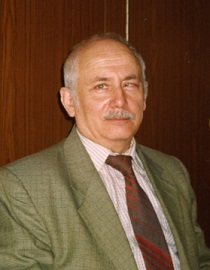
according to
Al`manac of Modern Metrology
№15 2018 (in Russian).
14 February 2018 the entire metrological community celebrated the eightieth anniversary of Kaufman’s Mark Borisovich birth. He was a talented and brightly researcher in the field of Earth’s orientation parameters (EOP) evaluation by the processing space geodesy and astrometry data (astrooptical observations (AO), very long base radio-interferometry data (VLBI), satellite and Lunar laser ranging data (SLR and LLR), GNSS data and others), an author of algorithms and programs of EOP combination, one of the founders of the State Service for Time and Frequensy and EOP evaluation (SSTF), who worked in FSUE «VNIIFTRI» from 1965 to 2014.
Mark Borisovich Kaufman – PhD of Physical and Mathematical Sciences, one of the founders Russian service of EOP evaluation. He was born in Moscow city on February 14, 1938. He was graduated from the Moscow Engineering Institute of Geodesy, Aerial Photographic Surveying, and Cartography (MIIGAiK) in 1962. He began his work as a student at the Moscow Aerogeodesic Enterprise, where he continued to work after graduation before joining FSUE «VNIIFTRI».
Mark Borisovich worked at the VNIIFTRI for 49 years Марк: since 1965 in Astronomical Time Laboratory (ATL) as a science researcher; since 1987 in EOP Evaluation Laboratory as a senior scientist, leader science researcher and head of laboratory.
He conducted scientific and practical work on astronomical observations in order to determine the Universal Time and coordinates of the terrestrial pole. He began his career as astronomical observer.
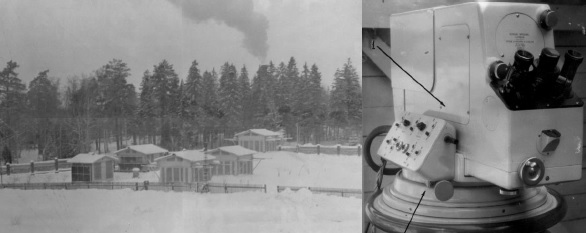
Astrooptical pavilions FSUE «VNIIFTRI» in 1975 (on the left)
and Danjon's astrolabe production by OPL (on the right).
Mark Borisovich did not complete a dissertation for the degree of Doctor of Sciences, but had truly academic knowledge and experience. This allowed him to conduct a lot of research and development work in a number of areas.
He participated in the development of a probabilistic and statistical method for evaluation of the Earth’s orientation parameters based on observations from observatories of the State Service for Time and Frequency and EOP evaluation (SSTF) in 1977. He was author of the algorithms and programs for combined processing of astronomical, satellite and VLBI data in order to evaluate the rapid EOP values. Mark Borisovich was engaged in research on theoretical and practical issues of using space navigation systems to solve problems of SSTF.
He was working not only in the laboratory. He represented the Russian EOP Service constantly participating in conferences (including foreign ones) and the media.
For example, he was talking about calendars, leap second and Earth’s rotation on TV show «This morning».
Mark Borisovich was an ardent enthusiast of his business and an active supporter of the introduction of new measuring instruments and methods of measuring data processing.
With his active participation, in 1987, the use of data for radio monitoring of Russian GNSS GLONASS orbits began for SSTF EOP evaluation [1] as such as using of Doppler measurements of Russian geodetic satellite GEO-IK, which was observed from 10-15 sites of Union of the Soviet Socialist Republic [2].
Also under his command in 1997 and in 2000 the ITALAS [3] – SLR data processing program, which was developed by VNIIFTRI order in ITA RAS by I.S. Gayazov, has been implemented and modified.
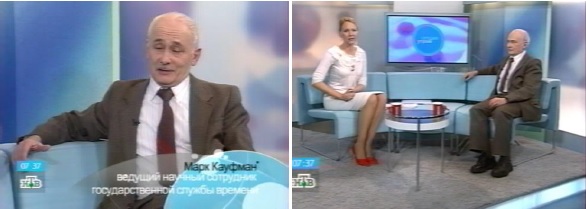
Mark Borisovich Kaufman answers the questions of the TV presenter on show «This morning»
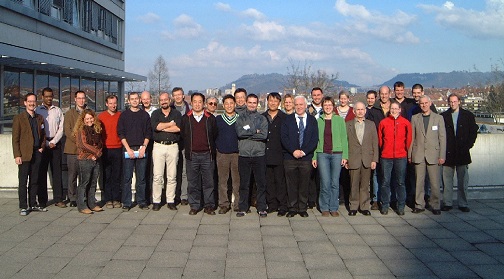
Mark Borisovich Kaufman at Bernese GNSS Software Introduction Course
(Bern, Switzerland, Astronomical Institute of the University of Bern (AIUB), 2006)
Mark Borisovich in the first row, the fourth from the right.
On his own initiative in FSUE «VNIIFTRI» the GNSS Software BERNESE 4.2 developed in AIUB [4] was purchased and has been implemented and upgraded to 5.0 and 5.2 versions after that.
The BERNESE GNSS Software is not program in the ordinary understanding. It is a program environment and program set, which investigator can used for his own tasks solving by writing his own control program for his own purposes. Control program has to prepare needed input data for every calling program and has to execute programs in needed order.
Mark Borisovich developed his own algorithm for daily EOP evaluation and control program, which provide execution of this algorithm in non-interactive mode (without human participation).
With all the advantages of satellite EOP evaluation methods, their main drawback is the fundamental impossibility of absolute evaluation of Universal Time UT1.
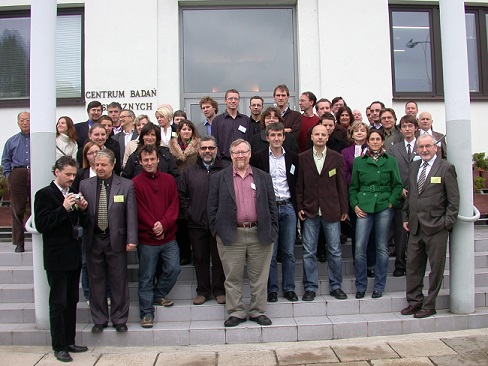
Kaufman M.B. is at group photo of participants of
IERS Workshop on EOP combination and prediction.
(Polish, Warsaw, Space Research Center of Polish Academy of Science, 2009)
Mark Borisovich is near the column on the right upstairs.
The very long base radio interferometric method (VLBI) allows to evaluate a complete EOP set. Mark Borisovich has been upgraded and implemented for operative daily EOP service in MMC SSTF [5] the VieVS VLBI Software developed in Institute of Geodesy and Geophysics of Vienna University of Technology, Vienna (Austria).
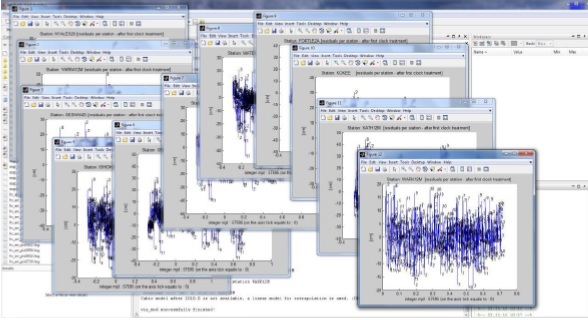
Interactive EOP evaluation by VLBI data processing in MMC SSTF with the help VieVs VLBI
Software which has been upgraded by M.B. Kaufman.
Mark Borisovich also developed first version of the orbits and clock GNSS GLONAS evaluation program.
He also devoted a lot of time and effort to mentoring work. Almost all the employees of today's EOP evaluation labarotory, as well as some of today's employees of the MMC SSTF, have passed through his mentoring
Mark Borisovich carefully selected the employees of his laboratory. Almost all of today's employees were found and brought to work in the laboratory by him.
He was awarded the medal "Veteran Truda", the badge "For Services to standardization", the diploma of Rosstandart. Mark Borisovich is the author of more than 70 published scientific papers.
He is the co-author of the fundamental work "Catalog of stellar positions of the USSR Time Services" (1971). From 1990 to 2014, he was the executive editor of the official bulletin of the GOSSTANDART "Universal Time and Pole Coordinates".
Mark Borisovich developed the current method of EOP combining processing for rapid EOP evaluation in MMC SSTF and has been implemented it in operative work in MMC SSTF in 2006 [6].
He took into account the ever-increasing requirements for the accuracy and delays of evaluated and predicted EOP values, which arise today, primarily in connection with the task of ephemeris and time support of the modernized system GNSS GLONASS.
In addition to significantly reducing the delay in data output, due to the possibility of involving a larger volume of measurements, his technique provided higher EOP evaluation accuracy as well as, thanks to the possibility of using the most recent measurements, better predictability.
The combining EOP values are evaluated by the combination of 9 independently EOP series formed by Combination and Analysis Center (MMC SSTF), Russian Academy of Science (IAA RAS) and ROSCOSMOS (SVOEVP, IAC KVNO).
As the analysis and long-term experience show, among these series, the most stable in a systematic way are the VLBI and GPS series, and average of it smoothing values, evaluated in MMC SSTF, was accepted as a reference of Russian EOP values. For others series systematic corrections were evaluated by the exponential smoothing of differences between EOP and a reference values. After taking these corrections into account, the averages of the EOP values of each series were formed with weights adopted based on the accuracy estimate for the previous calendar year.
According to the accepted methodology, the following main stages of combination processing were provided:
– removing systematic errors of the individual EOP series;
– calculated EOP weighted average;
– EOP prediction;
– results analysis and error analysis;
– creation of bulletins with EOP data.
EOP evaluation on every stage was executed for every EOP separately one from each other: Universal Time and Pole Coordinates. Resulting EOP values the values refer to 00:00:00.000 UT1 for every da
Calculations according to the accepted method are carried out in three cycles:
– daily – the operational EOP values for the past day and the prediction for the next 30 days are evaluated;
– weekly (every Thursday) the accumulated measurements for the past calendar week are processed, the systematic errors of the independent series used are clarified and the urgent (weekly) EOP values are calculated;
– monthly after 5 weeks after the end of the next calendar month, all accumulated measurements for that month are processed and the final (monthly) SSTF EOP values are calculated.
This evaluation method allows quickly, although with limited accuracy, obtain current EOP values and a forecast, and then refine them as new measurement data becomes available. So, when calculating operational and urgent EOP values a limited set of observations available at the time of processing is used.
The EOP evaluation are carried out in daily mode, every day in the morning and become acceptable before 07:00 UT.
As a result, the following types of information Bulletins about operational official EOP values are generated:
– SSTF Bulletin Q created in daily mode and includes the operational EOP values for the past day and the prediction for the next 30 days;
– first part of the SSTF Bulletine А is generated in weekly mode (every Thursday) and includes urgent (weekly) EOP values for the past SSTF week and 7 weeks prediction with weekly step. At the same time, the accumulated measurements for the past calendar week are processed and the systematic errors of the independent series used are clarified.
Errors are evaluated at all stages of calculations. Errors of combined EOP values is evaluated daily at the same time as the evaluation and the results are displayed in special work Bulletins R. They contain the results of the evaluation and formal EOP errors.
Every morning, including on holidays and weekends, the operator (before sending EOP data customers) performs a graphical review of the EOP evaluation results, which, if necessary, can be clarified using the Bulletin R data.
The very similar combination method is used now in MMS SSTF for daily EOP evaluation.
Today, the work, the foundation of which was laid by D.Yu. Belocerkovskiy[7] and M.B. Kaufman is continued [8]. The work carried out in the processing and analysis of measurement data for EOP evaluation purposes in MMC SSTF is at a high scientific and technical level. MMC SSTF equipment are being improved to decrease of errors and delays of EOP evaluation and prediction. The MMC SSTF activity which has been charged by governmental decree №225 which approved the provision "About State Service for Time, Frequency and Earth orientation parameters" is continued.
Mark Borisovich died on April 20, 2014. A memorial plaque has been installed in building 28 near room No. 417, where he worked in recent years. He still lives in the memory of his colleagues.

[1] Byhanov E.V., Kaufman M.B. EOP SSTF evaluation using GLONASS navigation system data. «Research in the field of time and frequency measurements», collection of scientific works VNIIFTRI. M., 1989 (in Russia).
[2] Boykov V.V., Caplan B.L., Maximov V.G. EOP evaluation by the geodetic satellite GEO-IK data processing. «Всемирное время и координаты полюса». GOSSTANDART USSR, Bull. E-65, M., 1991 (in Russia).
[3] I.S.Gayazov, М.В.Kaufman. Analysys of the weekly ERP calculations on the basis of SLR data. Annales Geophysicae. EGS, Suppl. 1 to the Vol. 14, Pt. 1, 1996.
[4] Bernese GPS Software. Version 4.2. // Univ. of Bern, 2001.
[5] M.B. Kaufman, S.L. Pasynok, Rapid EOP estimation using VieVS software, Transactions of IAA RAS, issue 23 (Proceedings of 4-th All-Russian conference KVNO-2011, 10-14 October 2011 Sankt-Petersburg, IAA RAS) - SPb.: Science, 2012, ISBN 978-5-02-038188-9, PP. 361-363.
[6] Kaufman M.B. Precise methods for measuring the EOP for navigation and time measurements // Precise measurements for high technology. – Mendeleevo, 2008. – PP.80 – 118 (in Russia).
[7] The founders of the metrological areas, David Yulievich Belocerkovskiy, Al`manac of Modern Metrology, №7, 2016, PP.189–192, ISSN 2313 – 8068 (in Russia).
[8] Blinov I.Yu., Pasynok S.L., Bezmenov I.V., Ignatenko I.Yu., Tsyba E.N., Vostruhov N.A., Redkina N.P., Sinev A.N., Sysak E.V., Chinilina M.A., Shlegel V.R., Zhestkov A.G., Activities of MMC SSTF for EOP evaluation in 2017, Al`manac of Modern Metrology, №13, 2018, PP. 9-61, ISSN 2313-8068 (in Russia).
04.03.2025
The EGU General Assembly 2025 will be held in VIENNA from April 27 to May 2 2025.
more information...





 pvz@vniiftri.ru
pvz@vniiftri.ru